
The Complex Ecosystem of a Developing Research Project
By Amanda West
One early morning in July 2013, I pulled out my tatty hiking boots, packed my backpack with borrowed plot flags, tape, and a GPS unit, and set off to pick up Amy, my friend and fellow GDPE (Graduate Degree Program in Ecology; Colorado State University) student. Amy graciously volunteered to help me that day to enjoy hiking in a nearby gorgeous monument of ecosystem protection, Rocky Mountain National Park. I had more specific motivation for our being in the Park; other than taking in the astounding beauty of those towering peaks and abundant flora and fauna, we were there to find the invasive Bromus tectorum (cheatgrass; Figure 1).
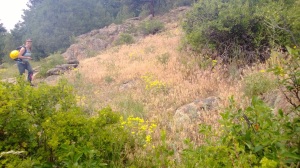
Most folks in the western United States are familiar with this invasive grass. It can be found along roadsides, in grazing and pasture land, and even slowly creeping up on dry slopes in the spaces between ponderosa pines. It can be problematic in any of these areas; not only does it compete for soil, light, and water resources with native grass species, but it may also degrade forage quality for mammals (e.g. elk, mule deer, and livestock), decrease wildfire intervals, and increase wildfire intensity.
Amy and I hiked to random locations in the Park that were selected based on the output from a bioclimatic niche model I developed with colleagues at NREL (Natural Resource Ecology Laboratory; CSU), BSPM (Department of Bioagricultural Sciences and Pest Management; CSU), FRS (Department of Forest, Rangeland, and Watershed Stewardship; CSU) and the National Park Service. The model was developed to evaluate suitable habitat for cheatgrass based on previously recorded occurrences of this invasive in the Park (Bromberg et al. 2011; West et al. In Review; Figure 2). Suitable habitat was identified for two time periods, present-day and in the year 2050.
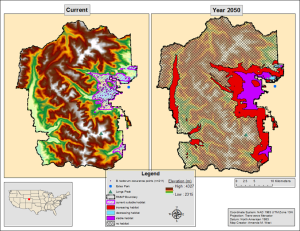
Bioclimatic niche models are powerful tools that use advanced statistical analysis such as hierarchical models and machine learning that may be used to evaluate macroecological patterns in geographic space. The field of macroecology is a rapidly emerging subdiscipline that addresses growing ecological concerns at regional to subcontinental scales; this field was recently highlighted in the February 2014 edition of Frontiers in Ecology and the Environment (Heffernan et al. 2014, Levy et al. 2014). A more detailed methodology for the bioclimatic niche model depicted in Figure 2 will be made available upon publication (West et al. In Review).
Less than a year before my trip with Amy to the Park, an unprecedented wildfire had occurred there. The Fern Lake Fire began October 9th, 2012, and spanned approximately 1,416 hectares (3,500 acres) in the Park at its peak extent (Figures 3 and 4). What was unusual about this fire was its persistence through the winter; the last observation of smoke from the fire was recorded on January 7th, 2013.
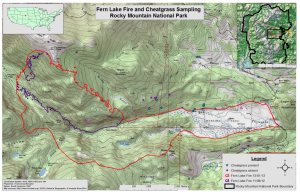
I had already planned to validate the current bioclimatic niche model in the field (Figure 2) prior to the Fern Lake Fire. Since the model partially encompassed the fire, I was immediately fascinated by it and began developing new questions concerning how this disturbance may influence future distribution of cheatgrass in the Park. Cheatgrass has been associated with the invasion-wildfire feedback cycle in various ecosystems (D’Antonio and Vitousek 1992; Brooks et al. 2004). In other words, cheatgrass has been shown to enhance fire, and it may become more abundant post-fire; this combination can have ecosystem to regional landscape effects.
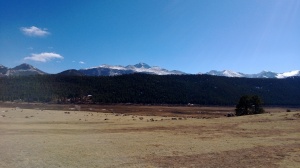
My research was based on the following postulate: that changing wildfire regimes coupled with a rapidly changing climate will result in the continued persistence of the problematic invasive cheatgrass in Rocky Mountain National Park. I developed this postulate into a research proposal, which I presented at FRSES (Front Range Student Ecology Symposium) in February 2013. Initially, the plan was to set up survey sites along an elevation gradient (i.e. three sites at every 100 meter gain in elevation) within and around the Fern Lake Fire, and monitor both previously recorded and newly established cheatgrass patches at these locations. Unfortunately, I did not acquire the resources necessary to set up over sixty research sites. Thus, with the limited funding I received, I decided to prioritize random survey locations that were both predicted by the current bioclimatic niche model and near the Fern Lake Fire.
Since starting this research it has expanded in complexity. Sara Simonson and Nicole Kaplan (NREL) joined me on one of the survey trips to the Park in 2013 to meet with a fire ecologist. I wanted to understand his perception of the Fern Lake Fire, and the association of wildfires and invasive species in the Park. After the meeting, we decided to hike on one of the trails in the Fern Lake Fire Area and look for invasive species. While stopping to observe a thick patch of Canada thistle (Cirsium arvense), we fortuitously came upon two individuals with the Park’s invasive species management team. Clad with backpack sprayers filled with herbicides and carefully spot-treating areas infested by invasive species, their presence reminded me of how I became so passionately involved in invasive species research years ago; I had performed similar work as part of a botany internship with the Student Conservation Association. While stopping to briefly chat with them about the invasive species they considered most problematic in the area, a local couple from Estes Park stopped to offer their observations as well. Sara, Nicole, and I began describing the growing complexity of the research project as a metaphor; the project “ecosystem” (Figure 5).
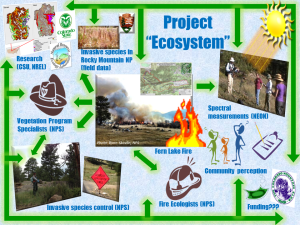
I had already discussed the ongoing research with vegetation ecologists at the Park; now we were gaining insight from the fire ecologist, the invasives control team, and the local community; what was next? The project also sparked interest from NEON (the National Ecological Observatory Network). Their idea was to incorporate in-situ reflectance spectra of cheatgrass into fine-scaled remotely sensed data of the Park, and we agreed to meet at some of the survey locations around the Fern Lake Fire where I had found large patches of the invasive grass. I took another trip to the park with Sara and Nicole, this time with new constituents (NEON) and a new objective (picture insert; Figure 5).
Since I am studying the ecology of disturbances such as invasive species and wildfires in Rocky Mountain National Park, I should mention a pertinent side note here: my field season was cut short in 2013 by a different kind of disturbance; the 2013 Colorado Floods began in September and washed away portions of Highway 34, my primary route to the Park from Fort Collins (Figure 6). Just another variable in the complex ecosystem of a developing research project!
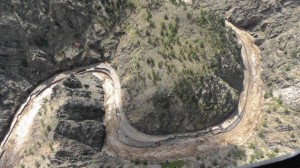
Concluding Remarks
New approaches in macrosystems are interdisciplinary, require collaboration, and take into account multiple perspectives and expertise (Cheruvelil et al. 2014). Sharing information with NEON and the National Park Service would allow me to enhance the validity and expand the application of model results. Understanding management and research objectives will position teams to better address issues associated with cheatgrass in the Park and beyond. At the onset of this research I had no idea how many people would be interested and provide their unique insights to the project. My visits to the Park in 2013 were made possible by a small research grant from The Colorado Mountain Club Foundation. Support was also provided by Tom Stohlgren and the USGS. The bioclimatic niche model was developed with funds provided by USDA-NIFA. I would like to thank Sunil Kumar, Amy Birtwhistle, Sara Simonson, Nicole Kaplan, Rich Fordham, Cynthia Brown, and numerous individuals with the National Park Service and NEON for assisting in this research.
Although the complexity of a developing research project may seem overwhelming, as Ecologists we are always fascinated by dynamic systems. The ecosystem is nested within the other hierarchies of the natural world; this project “ecosystem” is no different!
References
Bromberg J. E., S. Kumar, C. S. Brown, and T. J. Stohlgren (2011). Distributional Changes and Range Predictions of Downy Brome (Bromus tectorum) in Rocky Mountain National Park. Invasive Plant Science and Management 4:173–182.
Brooks M., C. M. D’Antonio, D. Richardson, et al. (2004). Effects of invasive alien plants on fire regimes. Bioscience 54:677–688.
Cheruvelil, K. S., P. A. Soranno, K. C. Weathers, P. C. Hanson, S. J. Goring, C. T. Filstrup, and E. K. Read (2014). Creating and maintaining high-performing collaborative research teams: the importance of diversity and interpersonal skills. Frontiers in Ecology and the Environment 12: 31–38.
D’Antonio C. M. and P. M. Vitousek (1992). Biological invasions by exotic grasses, the grass/fire cycle, and global change. Annu Rev Ecol Syst 23:63–87.
Heffernan, J. B., P. A. Soranno, M. J. Angilletta, et al. (2014). Macrosystems ecology: understanding ecological patterns and processes at continental scales. Frontiers in Ecology and the Environment 12:5–14.
Levy, O., B. A. Ball, B. Bond-Lamberty, et al. (2014). Approaches to advance scientific understanding of macrosystems ecology. Frontiers in Ecology and the Environment 12:15–23.
West A., S. Kumar, T. Wakie, C. Brown, T. J. Stohlgren, M. Laituri, and J. Bromberg. (In review). Using high-resolution future climate scenarios for predicting invasions in National Parks. For Biological Invasions.